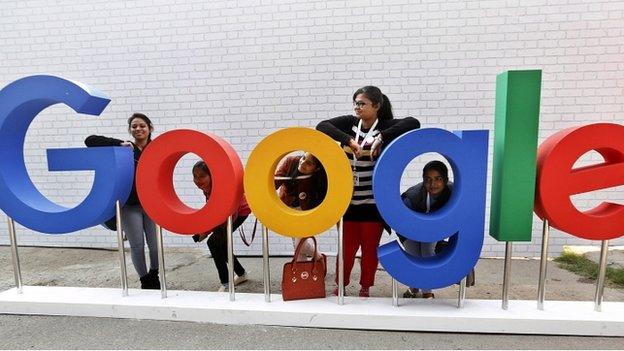India is top target for online universities
- Published

India's ambitions for millions more graduates each year will require online university courses
India, with its huge education-hungry population, is the prime target of one of the world's biggest online university providers.
Coursera, with 17 million registered students and free online courses from 140 universities, wants to be part of India's drive to expand access to higher education.
This Californian company is one of the trailblazers of the so-called Moocs (massive open online courses) which run courses for students studying at home, but usually without accredited degrees.
At present only about 12% of young people in India get university places - and Rick Levin, Coursera's chief executive officer, says there are an "awful lot of talented people" who "don't make the cut".
What makes this an even bigger opportunity for online providers is that the Indian government has a target to increase university enrolment by 30% by 2030.
Dr Levin says this is "hugely ambitious" and then qualifies it further as "frankly almost impossible" if such an expansion were to depend on building new bricks and mortar universities.
It would mean establishing "literally a couple of thousand universities" as well as expanding the existing institutions, he says.
Software industry
Instead Dr Levin, a former president of Yale University, believes it will be online courses that will fill the gap and widen access to university for India's ambitious youngsters.
Coursera already has 1.3 million students in India, the biggest concentration of online students outside the US and China.

Rick Levin, Coursera CEO and former Yale head, says online courses known as Moocs have moved on from early hype
Dr Levin says that the 10 most popular courses for these online students are all related to information technology or data science.
And India's burgeoning software industry will mean a growing demand for skilled workers.

More stories from the BBC's Knowledge economy series, external looking at education from a global perspective and how to get in touch

At the moment he says India's higher education system, with its elite, highly-selective institutions, does not have the capacity to meet the aspirations of a young and talented generation.
"The economic opportunity is great and there are an awful lot of bright people who don't get the benefit of an education their potential deserves," he says.
Employer recognition
Coursera offers free online courses from universities including Yale, Stanford, Columbia and Edinburgh.
But they do not lead to an external exam or an accredited degree.

Google logo in New Delhi: Technology courses are the most popular for online students
And the long-anticipated next step has been when such universities will use the Mooc model to offer fully-fledged online degrees.
Dr Levin says this is the longer-term direction of travel.
But more immediately, particularly in places such as India, he says the most valuable kind of recognition is from employers, when they accept online Mooc courses as relevant for job applications.

Coursera, one of the Mooc pioneers, has signed 17 million students for its courses, including 1.3 million in India
"That's a hurdle that doesn't require accreditation, it's a marketplace recognition. That's going to move faster than any accreditation process, it's market driven not bureaucratic."
When Moocs first appeared a few years ago they were hailed as a revolution in higher education, promising the kind of impact the internet had brought to retail and entertainment.
Skills gap
Dr Levin says that as an economist he recognised the "cycle of hype" surrounding Moocs.
Likening it to the current interest in self-driving cars, he says there were exaggerated expectations that they would "change the world immediately".

India's young population faces a changing economy and expanding education system
But he says it should not have been a surprise to anyone that "500-year-old institutions didn't just roll over and die".
"What's really happening is something socially valuable - we're closing the skills gap, giving people an opportunity."
Coursera will have plenty of competition to attract India's students.
Traditional campus-based universities in the US have been attracting rapidly rising numbers of Indian students, up by almost 30% last year and second only to China.
Local partners
This is a tough market and figures for UK universities last week showed the fourth consecutive annual fall in students coming from India, with less than half the number of students compared with 2010-11.
But the UK's distance learning university, the Open University, has ambitions to increase its reach in India.

Big population, big ambitions: A mass participation science experiment in Delhi
The approach is not to offer courses directly, but to work with local institutions and support courses accredited by Indian universities.
"They will deliver their own local qualifications," but with content and online teaching resources provided by the Open University, says director of external engagement Steve Hill.
"It would be wrong for a foreign university to say we're here to solve your problems, we're going to set up a campus and we're going to offer our qualifications," he adds.
This approach of working with local partners has reached 200,000 students in China, says Mr Hill and the Open University hopes to reach similar numbers in India.
Mr Hill also sees distance learning as a practical way for India to reach its target for another 14 million university places in less than 15 years.
The Indian higher education sector could not realistically expand that quickly in terms of traditional universities, he says.
And even if overseas universities were allowed to open campuses in India, it would be a risky financial model and would be limited in how many students could be reached.
"The only way it is going to reach its target is online. India has to embrace distance learning," says Mr Hill.
At present, India has 3.5 million students on distance learning degrees and the OU chief executive argues that this is going to have to increase significantly.
A recent report from the British Council forecast that by 2025 India will have the biggest student-age population in the world. It means a decade of even more intense competition from international universities for a share of this expanding market.